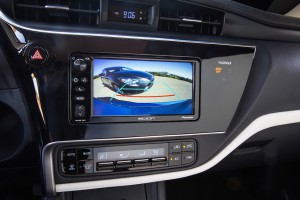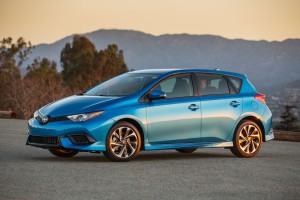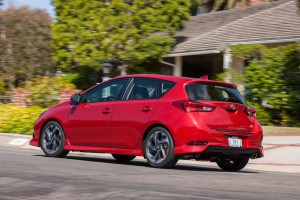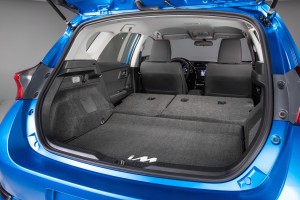Scion is in the middle of a revamp of its line-up to reinvigorate its youthful buying base and as part of that, it’s debuting the new iM that slots right into a growing segment in the U.S.: hatchbacks.
Actually, what’s really getting attention is the “hot hatch” group and, to be honest, powered by a 1.8-liter four cylinder putting out 137 horsepower, the iM is not in that group, which includes things like the Focus RS, the JCW Mini, VW Golf GTI, Chevrolet Sonic RS and the Fiat 500 Abarth.
However, with a six-speed manual, comfortable seats combined with an aggressive exterior, Scion gives potential buyers a fresh offering of a growing product segment that is a lot of fun to drive … when you wring out that little engine.
To be fair, Scion’s iM isn’t really looking to get into a wrestling match with a Fiesta ST, but that isn’t really the brand’s goal. It’s looking to provide buyers good value with style, convenience and versatility and the iM’s got that in spades, starting with the distinctive piano black front fascia and hexagonal grille that makes the iM look, well, angry … almost as if it has something to prove.
It comes in seven colors Blizzard Pearl, Classic Silver Metallic, Black Sand Pearl, Barcelona Red Metallic, Spring Green Metallic and Electric Storm Blue. While the silver is kind of ho-hum, and the Spring Green Metallic will likely be the favorite of the under 25 crowd, the blue and red are showstoppers with the blue being the best looking of the group.
Scion’s vehicles are all “monospec,” which means the car comes pretty well equipped for less than $20,000. There are basically two IMs to choose from: the $18,460 for the manual transmission and $19,200 for the CVTi- S model. A $795 delivery, processing and handling fee is not included in the MSRP.
What are the other options? Basically, you have to decide if you want a navigation system for $395. There are a few other items available from Scion, including body graphics, cargo area enhancements, interior light kit and all-weather floor mats, to make it look and feel sportier.
In addition to coming in below $20K, the iM is easy on the bank account when it comes to gas. While gas prices are currently as prices so low – in most areas of the country anyway – that drivers pinch themselves every time they stop at a gas pump, the iM only enhances that feeling by getting an EPA estimated 28 city/37 hwy/32 combined for the CVTi-S model and 27 city/36 hwy/31 combined for the six-speed manual.
All of this value-oriented stuff is fine, but brand’s buyers are young and they not only want to save a buck, they expect a lot for the bucks they are spending, according to the Scion officials. In terms of performance and handling, I’d say it delivers, but you’ve got to work at it.

The dash and center console get a very sleek looking, glossy black treatment with a 7-inch touchscreen radio/nav system really stands out.
The car launches nicely from a standstill, but in order to get sufficient power to pass (or simply enjoy curvy roads) keeping the RPMs in the 4,000 range is vital. Once I figured that out, it was a pleasure having the control of the six-speed manual. The automatic features a “Sport” mode with seven shift points aimed at providing a similar result.
(Scion looking to make buyer process quicker, easier. For more, Click Here.)
While the automaker gets sport mode, the manual gets Hill Start Assist, which helps prevent rollback when pulling away from a stop sign or traffic light on an incline, as standard equipment.
Sitting on 17-inch alloy wheels with four-wheel independent suspension, including the double-wishbone rear and high-strength steel the iM delivers a ride that ranges from comfortable to predictable. While that sounds like a slight, it’s not. In a little car like the iM, knowing it will react predictably is a bonus.
Again, it’s not a hot hatch with a hugely beefed up suspension to match the screamingly powerful engine. It performs well for a small car, it’s just not a sports car and for $20K, that’s pretty good.
However, if you want to squeeze out some improvement in the iM’s performance, Scion’s got you covered. Through Toyota’s Racing Development arm buyers can add an air intake system, sway bar, lowering springs and other items aimed at improving the hatchback’s on-road performance.
On the inside, the iM really shines. The dash and center console get a very sleek looking, glossy black treatment that allows the gauges to be easily read and the 7-inch touchscreen radio/nav system really stands out. The screen is also used for the standard rear-mounted camera. It’s a very attractive package. The only downside to it was that occasionally I had a hard time seeing the screen due to sun shining in.
(Click Here to see more about Scion’s plans to reconnect with young buyers.)
The sound system was clear and easy to use. It easily connected to my iPhone via Bluetooth and phone calls were clear, although others driving the iM reported that people at the other end of the phone line reported difficulty hearing clearly until the air conditioner was turned all the way down: a problem I didn’t experience.
The 4.2-inch color TFT multi-information display (Scion’s first) between the main instrument gauges provides displays for the car’s audio system and other functions. Adjusting the view on what you want to see takes a little work at first, but it’s not difficult to master and would be second nature after an hour behind the wheel.
An abundance of soft-touch materials on the inside give the car a look of a vehicle that’s more expensive and there is enough sound deadening material to keep road noise to a minimum adding to that perception.
Scion likes to borrow from its more expensive cousins at Toyota and Lexus and the iM does with with dual-zone automatic A/C control, color-keyed heated power-folding exterior mirrors (clear up fog or frost in a hurry, and auto on/off headlamps are another convenience typically found on more expensive models.
(To get TDB’s first impressions of the new Scion iA, Click Here.)
The 2016 iM is covered by a three-year/36,000-mile limited warranty and five-year/60,000-mile powertrain warranty. It also comes with Scion Service Boost, a complimentary plan covering normal factory-scheduled maintenance for two years or 25,000 miles, whichever comes first, and two years of 24-hour roadside assistance.



